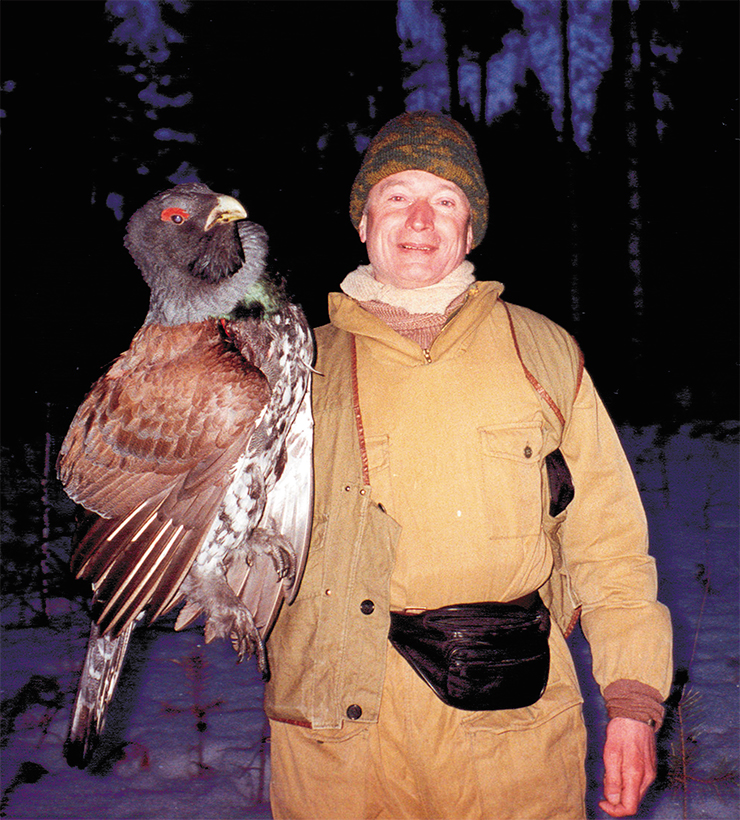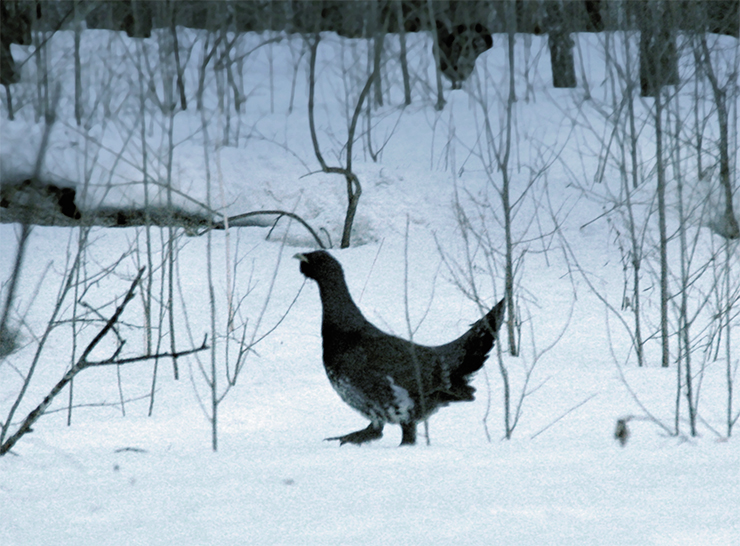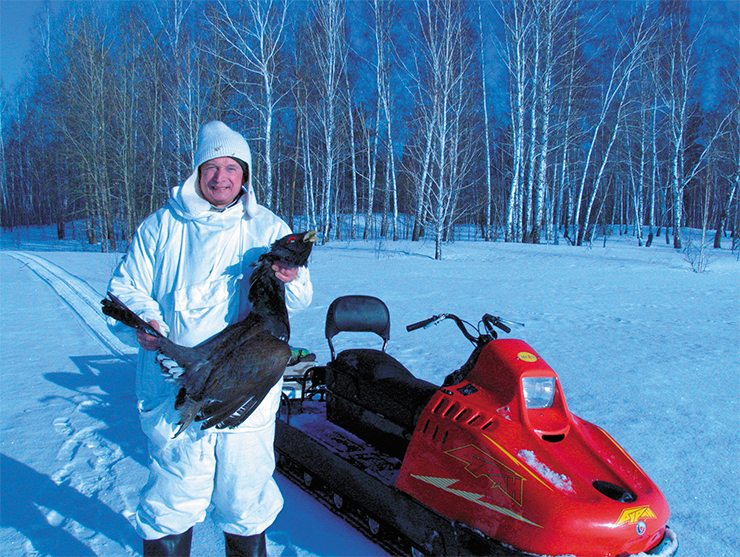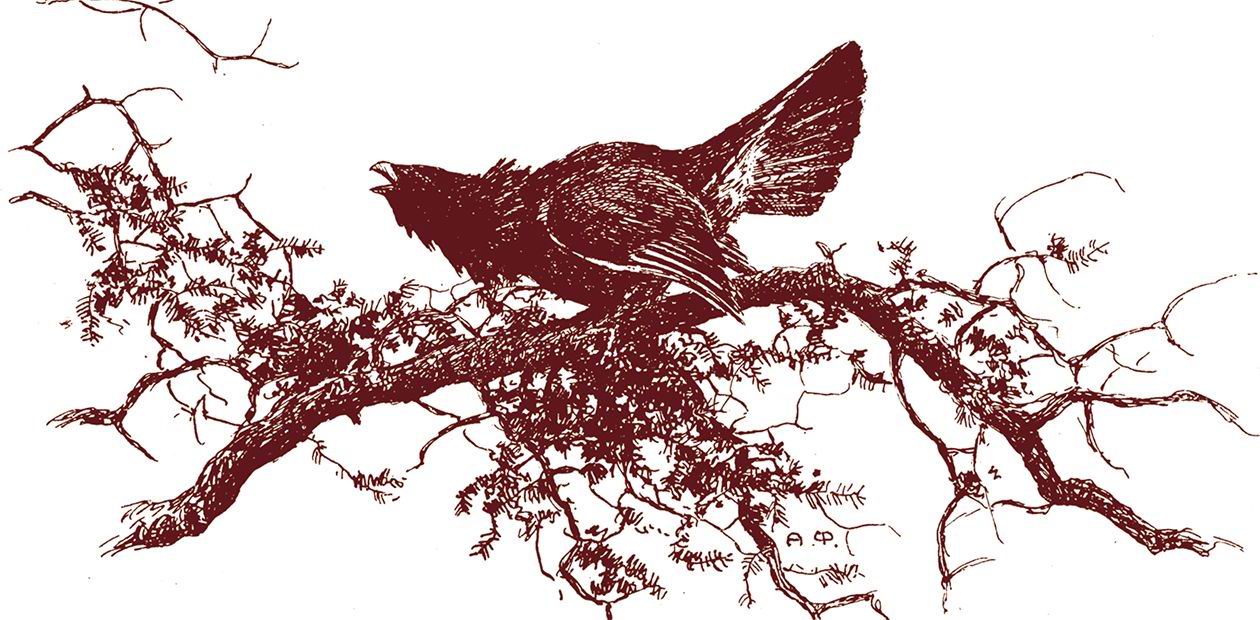Song of the Taiga Aboriginals
Every Russian remembers a famous poem by Yesenin: “The scarlet of dawn is woven on the lake surface, wood grouse cry in the pine forest, uttering their mating-call…” Songs of these reserved taiga inhabitants have become a symbol of spring love celebration for many poets: a renowned singers’ caf in Moscow is called A Wood Grouse’s Nest; country feasts cannot do without songs about wood grouse, and hikers’ or hunters’ camps, without a popular song by A. Rosenbaum: “On the mating place, wood grouse hit each other’s chest till it bleeds. They get so excited that one fears for their life…”
Why are wood grouse so popular? First, the spring courting of these huge relict dense forest residents really looks impressive. Second, it is a wood grouse (not an eagle) that can be called a truly Russian bird. There was a time when the wood grouse’s natural habitat extended as far as all the northern part of Eurasia. Today, European countries have few of these birds left: they can be found only in zoological gardens. Only in Russia, there is still a considerable amount of wood grouse. They are not like inconstant migrant birdies, for they patiently wait for the winter hardships in their homeland to be over, hiding under snow and feeding on pine needles. Thanks to their reserved mode of life in the remotest depth of the forest, they got their Russian name (“gloukhar” is derived from the adjective which means both “deaf” and “remote”).
Special literature gives scarce information about them: the largest of grouse, they make their nests on the ground; there are usually eight eggs in a laying; wood grouse suffer from predators such as eagles, eagle owls, martens, etc.; male birds weigh from 4 to 5 kg, hens weigh half this weight.

Wood grouse fall into a spring mood already in March when migrant birds just start preparing for a long journey to the north. At this time male grouse begin walking on the thin frozen snow-crust by the future meeting place – the display ground, which remains on the same spot for many years. Usually, it is a remote moss bog surrounded with pines, on whose branches wood grouse enjoy sitting. Everybody has seen a picture, competing for popularity with Shishkin’s famous “Morning in the Pine Forest”, of a wood grouse sitting on a branch with its head thrown back, which is a typical pose for singing.
Wood grouse walk by the future display ground with their tails fluffed up and their wings trailing on the snow, leaving characteristic furrows. They draw on the snow, as hunters call it. In the beginning of April hens sometimes come to visit the walking dandies. The courtship display only begins, there are no songs yet, the birds meet and stroll together.
It grows warmer, and wood grouse start singing in the trees. Silently, they come flying to the mating place in the evening, and until the morning they quietly sleep in the pines grasping the branches with their claws. At this time, thawed patches have already appeared under the trees, so that wood grouse can run about and twist their fluffed tails without catching on the ice crust. It is quite possible to sing up in the tree, but in order to mate the birds have to go down to the ground. A male wood grouse is polygamous, while it is a hen that chooses a mate for herself during the courtship display. The males try their best to sing well. Their songs are not very pleasant for a human ear, but they are not destined for us. Above all, they should be pleasant for their “girlfriends”.

Wood grouse start to sing in the early morning, before dawn. At first they click as if using castanets, something like “tek-tek-tek…” comes out. The clicking gets more and more frequent, and then there comes the sound of sharpening a knife with a rough whetstone. When a wood grouse starts to “whet”, it gets switched off completely: it doesn’t hear anything, and many people say that it hardly sees anything. Having warmed up to singing and gone into ecstasy, the males jump down and make a show of strength or have a real tournament. Hens come closer and choose the singers they like. Note that it does not make sense to get too excited about tournaments: according to investigations, the most passionate singers or fighters do not necessarily make the most successful mates, for they can get carried away and forget about the true purpose of the show. Meanwhile a less loud-voiced and less muscular rival can lead the “lady” away on the sly. As a result, a talented dandy will remain empty-winged when happy couples wander off to the bushes.
It is getting warmer, May comes, and mating places gradually become silent. Adult males sometimes start to sing out of habit, and then go on to have their morning meal right away. Young males may also try singing now and then, though not very hard. And then there comes the time for hatching and breeding the nestlings – the usual birds’ summer life full of worries…
However, the birds’ life is not that safe. The tragedy of wood grouse is that they are totally unprotected during the courtship display, for their temporary deafness is a piece of luck for hunters. Hunting for this very cautious bird is the first and most well-known spring hunt. Few people have been to wood grouse’s mating places, but those who were lucky will never forget it and will certainly try to get there again. For the hunting events happen in a beautiful place (the birds choose only such places for the display ground) and always in fine weather when the eastern part of the sky becomes colored with the first rays of the sun.

This hunt, as they say in hunting books, “…is a remarkable sport; it demands strenuous exertion, and a lot of energy and stamina from a hunter”. Our forest roads, which in early spring exist only on maps, make it even a “greater sport”. And then there are ticks, which at this very time crawl out onto the blades of grass to be on the watch for their victims.
A classical wood grouse hunt goes like this. Hunters come to the display ground when it is dark and sneak up to the place from which the wood grouse’s clicking is heard (it can be heard approximately 150 meters from the bird). When they get quite close to the bird, they can move rushing only during the “whetting”, which lasts two or three seconds. When the bird is quiet, hunters should stay motionless until it starts “whetting” again, in whatever posture or whatever puddle they find themselves. Having approached the tree from which the song is heard, hunters have to manage to discern the bird.
So it is not without reason that hunters tell legends about their wood grouse hunts. Some say that the “girlfriends” of the taiga dandies can intentionally hinder a hunter and even attack people. Others remember up old tales about hunting wood grouse in ancient Germany, where royal persons moved a newly cut fir-tree in front of them for camouflage, or jumped up to the tree with a wood grouse in it with the help of a pole. A. Formozov, an outstanding scientist, artist and writer, described a wood grouse hunt best of all, so I gladly refer everybody who is interested to his book.










